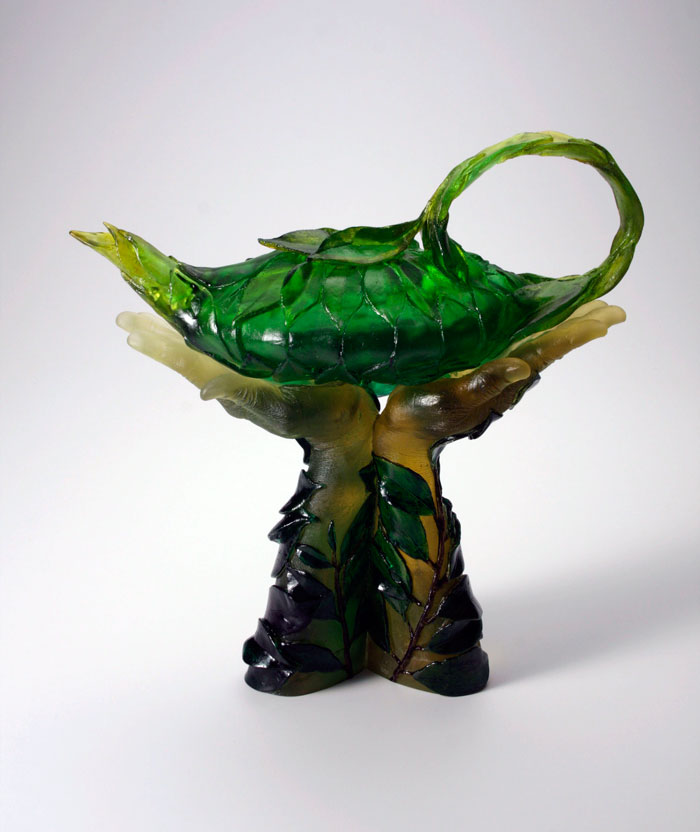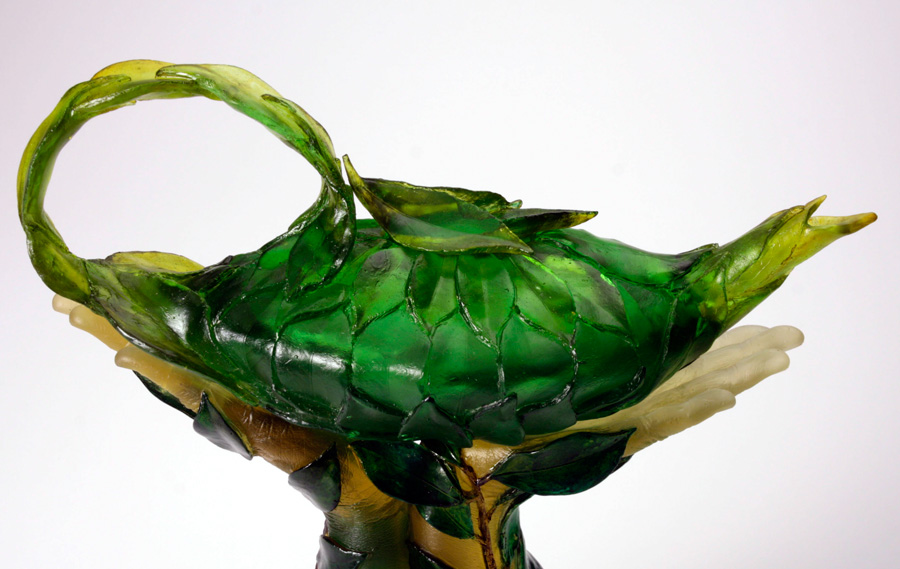“…Our ideas are generated by the flow of making and our shared curiosity and wonder of the world (and people) around us…”[i] – John Littleton & Kate Vogel
For artists John Littleton (American, b. 1957) and Kate Vogel (American, b. 1956)[ii] “the give and take of ideas has become as natural as breathing.” [iii] Over the past forty years this husband-and-wife team have created blown and cast glass sculptures that reflect “a deep and abiding respect for the generative processes of human life, and a personal commitment to unity and simplicity of visual form.”[iv] Concepts develop “from dialog relating to feelings, thoughts, dreams, and ordinary experiences. The work evolves and grows as [Littleton and Vogel] journey through life.”[v]
In 2012 Littleton and Vogel completed a commission entitled Homage to a Teapot for the Kamm Teapot Collection. In this blog post we will take a closer look at this multicolored cast glass sculpture and we will share how these two talented artists started their collaboration.
University of Wisconsin
Littleton and Vogel met in the glass shop at the University of Wisconsin – Madison while they were working on their bachelor’s degrees. Littleton had spent a great deal of time around the school’s campus in his youth. His dad Harvey Littleton, who is considered the father of the American studio glass movement, had founded the first college level glass program in the nation at the university.[vi] As a child the younger Littleton witnessed the early achievements occurring in studio glass. However, he initially chose a different path of study than his father. Instead, he focused on photography.[vii]
At the University of Wisconsin, Vogel originally concentrated on drawing and painting. Then in 1977 she signed up for a summer course at Santa Reparata Graphic Art Centre in Florence, Italy.[viii] While studying in Italy, Vogel visited the Venetian island of Murano where the tradition of glass making dates back to ancient times.[ix] After this experience, she devoted her time to glass and metalwork during her final year in Madison.[x]
Collaboration
Littleton and Vogel began collaborating in 1979 in the mountain town of Spruce Pine, North Carolina. There in Harvey Littleton’s studio, which he had set up after retiring, they began their journey creating blown and cast glass sculptures.[xi] In 1980 Littleton and Vogel moved to nearby Bakersville where they set up a studio of their own.
At the beginning of their collaboration, they received a great deal of attention for a series of blown glass bags. These sculptures resemble simple fabric bags with a tied string closure. With these works Littleton and Vogel investigated “color, containers and containment, and form. Over time, the soft forms…[took] on personal elements. For example, they mimic the “playful relationship of [Littleton and Vogel’s] collaboration and family life.” [xii] Since the bags, they have developed a diverse body of work which ranges from figural castings to elaborate cast glass and forged steel tables. Collectively, these creations have continually explored “the dual themes of hard and soft, open and closed, revealing and concealing, heavy and light, and fragile and strong…”[xiii]

Kamm Collection
For the sculpture Homage to a Teapot Littleton and Vogel explored tea’s long rich history. They spent time researching its ancient origins as well as the different types of tea leaves and how it is produced. Ultimately, Littleton and Vogel felt it was important to create a work that not only emphasized connections to the natural world, but the human relationship to this time-honored drink. In essence, the sculpture needed to acknowledge not only the people who grow and make the tea, but also those people who serve and drink the tea.[xiv]
Homage to a Teapot includes two upright pale-yellow human arms wrapped in leafy branches from a tea plant.[xv] In the sculpture’s splayed open hands rests a teapot made of green-colored tea leaves. This translucent teapot, with its looping handle and short spout, is being ceremoniously presented to the viewer with a great sense of reverence. This cast glass design was not Littleton and Vogel’s first and only idea. Initially they had discussed doing a blown glass work and at least one earlier version included a teapot pouring tea. However, Littleton and Vogel, after discussions with the Kamms, decided to cast the form and go with this tribute.
In past work Littleton and Vogel had incorporated arms, hands, and plant life. However, this was, and continues to be, the only time they have created a teapot form.[xvi] The design came with its challenges. Using foliage from the camellia plant, which is a close relative of the tea plant, they created countless leaves to build the teapot structure. [xvii] However, issues arose when combining the multiple wax versions of these leaves during the casting process. Finding the right approach required time, but eventually it came together. Furthermore, a great deal of research was done on the colors applied to the tea leaves encircling the arms. Littleton and Vogel carefully selected colors with a transparent quality and used techniques that would allow these elements to be as archival as possible.[xviii] This research process and dealing with technical issues may have become arduous on occasion, but Littleton and Vogel seem to embrace these challenges viewing them instead as opportunities for growth.[xix]
Currently Littleton and Vogel are in the process of completing another commission, a twenty-two-foot-tall outdoor sculpture for the city of Muskegon, Michigan. This stainless steel and glass design will be installed in a roundabout in front of the entrance to Pere Marquette Beach on Lake Michigan. In September of 2021 Littleton and Vogel will also be exhibiting their work at the Bergstrom-Mahler Museum of Glass in Neenah, Wisconsin.
FURTHER READING/VIEWING:
Art Alliance for Contemporary Glass. Littleton Vogel. April 17, 2019.
Asheville Arts Museum. Conversation with the Artists: John Littleton & Kate Vogel. June 17, 2020.
John Littleton & Kate Vogel Studio Tour. April 2, 2020.
John Littleton & Kate Vogel Glass in Motion Sculpture. April 12, 2020.
Monroe, Michael W. Clarity Imprisoned: The Art of Kate Vogel and John Littleton. Maurine Littleton Gallery: Washington, DC, 2001.
Toe River Arts. Inside the Studio – John Littleton and Kate Vogel. January 8, 2018.
Notes:

